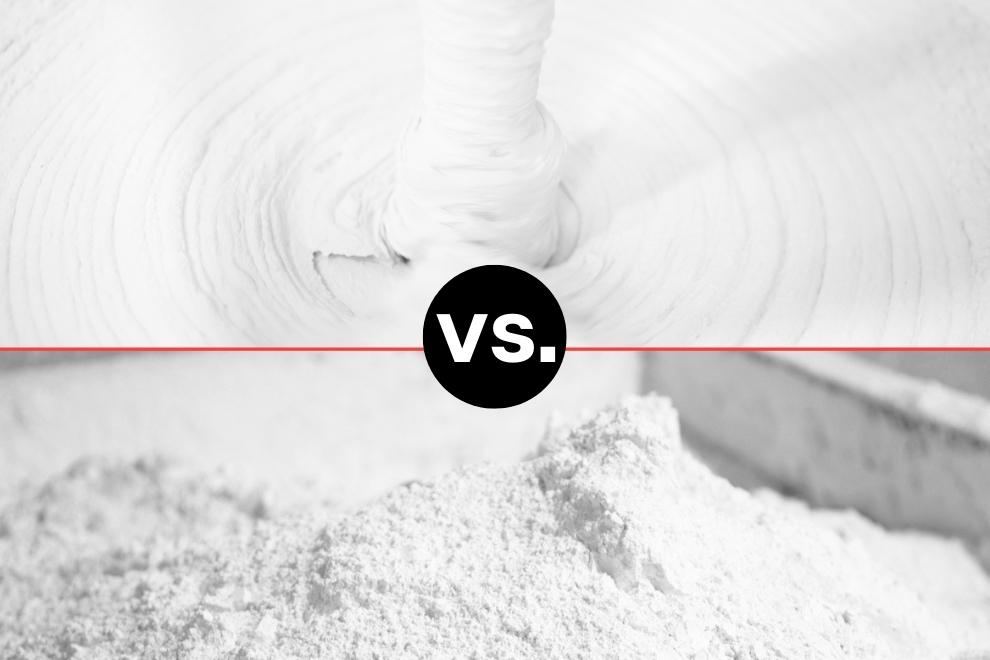Powder filler or ready mix?

Initially only available in powder form, fillers intended for professionals are now very often available as both powders and ready mixes (‘ready-to-use’). Which one to use depends on the type of work to be done, but also habits! Processionals are turning more and more to ready mixed versions because they have been trained in these products. So how do you choose between powder filler and ready-to-use filler for your job? What are the properties and benefits of each type? We take stock of the differences between each to help you make the right choice.
Powder fillers: for applications with little or no shrinkage
Preparing powder fillers: problem or benefit?
The first difference between powder filler and ready-to-use filler lies in the preparation. Unlike ready-to-use filler, powders must be mixed with water before use. In small quantities, the mixing is most often done by hand in a tub. For large volumes, a mixer is generally used.
Preparing a powder filler requires a bit of time of time and can be problematic for sites that don’t have access to water or electricity. On the other hand, being able to mix the filler to the desired consistency is a real asset. An ideal mixing rate is in all cases indicated on the packaging as an indication, but professionals may choose to make a looser or tighter mix.
Less working time, but no depth limits
Once they’re mixed, powder fillers have a limited working time after which they can no longer be applied, because they can no longer be manipulated (irreversible hardening has begin). This window varies between about thirty minutes and several hours, depending on the product.
These different working times generally correspond to the type of job the filler is designed to do. For example, when general localised holes have to be filled, a short setting time (30 to 45 minutes) is particularly suitable, but when a professional needs to time to apply a coat of filler over large surfaces (smoothing or skimming, for example), the working time will be much slower and can range from a few hours up to a full day in certain cases. To avoid scrappage, it’s important to take care to prepare appropriate batch sizes.
Powder fillers can be applied in thick layers in one pass as well as in thin layers and often prove to be more suitable for localized applications and in very thick layers, such as Toupret powder fillers which are recommended when deep holes need to be filled. This ‘no depth limit’ characteristic is specific to this group of fillers. Others are suitable for smoothing over badly damaged or textured surfaces and are designed to be applied up to 5 mm thick.
Powder fillers harden without shrinkage
A uniform chemical reaction begins between certain components of the powder filler and the water once they have been mixed together. In this reaction, the powder first hardens by setting (crystallization) before it dries. This type of setting avoids the occurrence of shrinkage. The reaction which may be faster or slower, depending on the product, but it’s irreversible.
Long life and more…
Stored in suitable conditions, i.e. away from humidity, powder fillers can be kept for a long time.
Good to know: when it comes to indoor air quality, Toupret powder fillers all have an A+ rating. This means they’re the least emissive on the market.
Ready-to-use fillers: practical and easy to use on site
Ready-to-use, versatile and easy.
Ready-to-use fillers do not require mixing. Their consistency is finely adapted in the factory to the intended use. Their mix is smooth, homogeneous and has a constant consistency.
On a busy site (renovating a private home for example), ready-to-use fillers have the benefit of not generating dust due to mixing.
They also don’t go off (no limit to working time). Once the day is over, simply put the lid on the tub or bucket ready to reuse the next day. Less waste too!
Longer curing time can mean limited usefulness
Compared to powder, ready-to-use fillers take longer to harden. They harden as the water in them evaporates and this can also lead to some shrinkage, depending on the quality of the product used. The longer hardening time also means a longer wait to apply a second coat. This is why ready to use fillers have a limited recommended application thickness for filling jobs, usually to a maximum of 10mm.
There is one exception, however. ‘Lightweight’ ready mixed fillers can be used without depth limits for filling jobs. Thanks to this technology that you will find in our Quick Fill products for interiors and exteriors, they can also be painted just 30 minutes to 1 hour after application (approximate time, depending on substrate, application thickness and humidity).
When using ready-to-use fillers for coating jobs (levelling or fine smoothing), the application limits are similar for powder and ready to use products: 5mm for the levelling and up to 2mm locally for the fine smoothing.
Keeping ready-to-use filler at its best
Stored in the right conditions, i.e. in an airtight container, away from frost and direct sunlight, ready-to-use fillers will keep for a long time.

